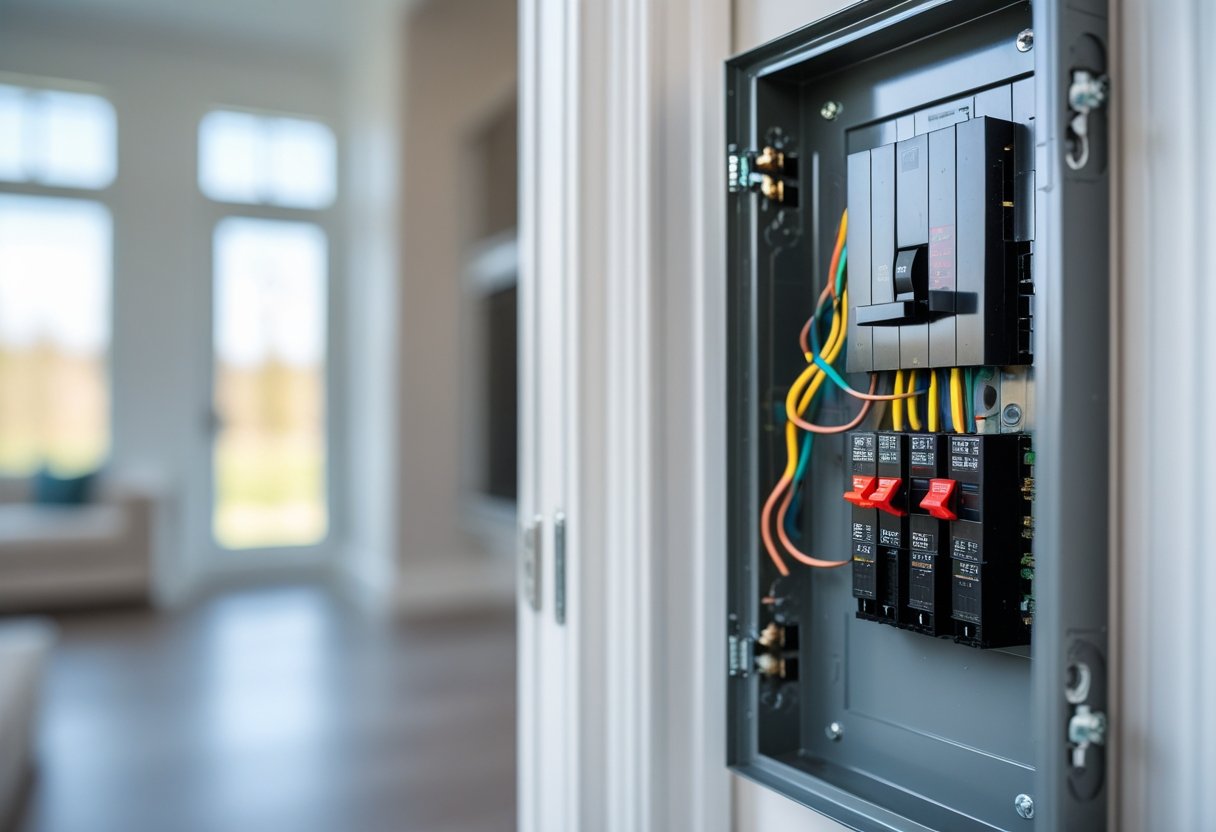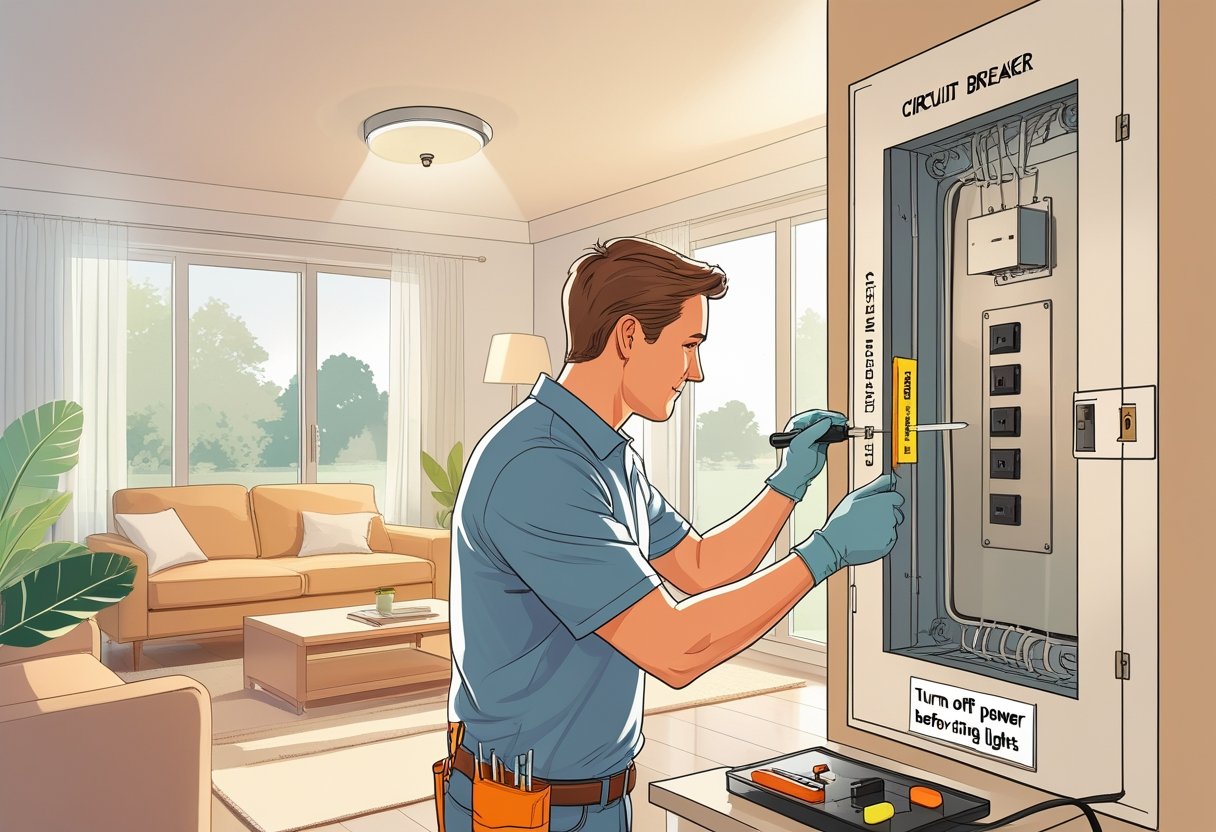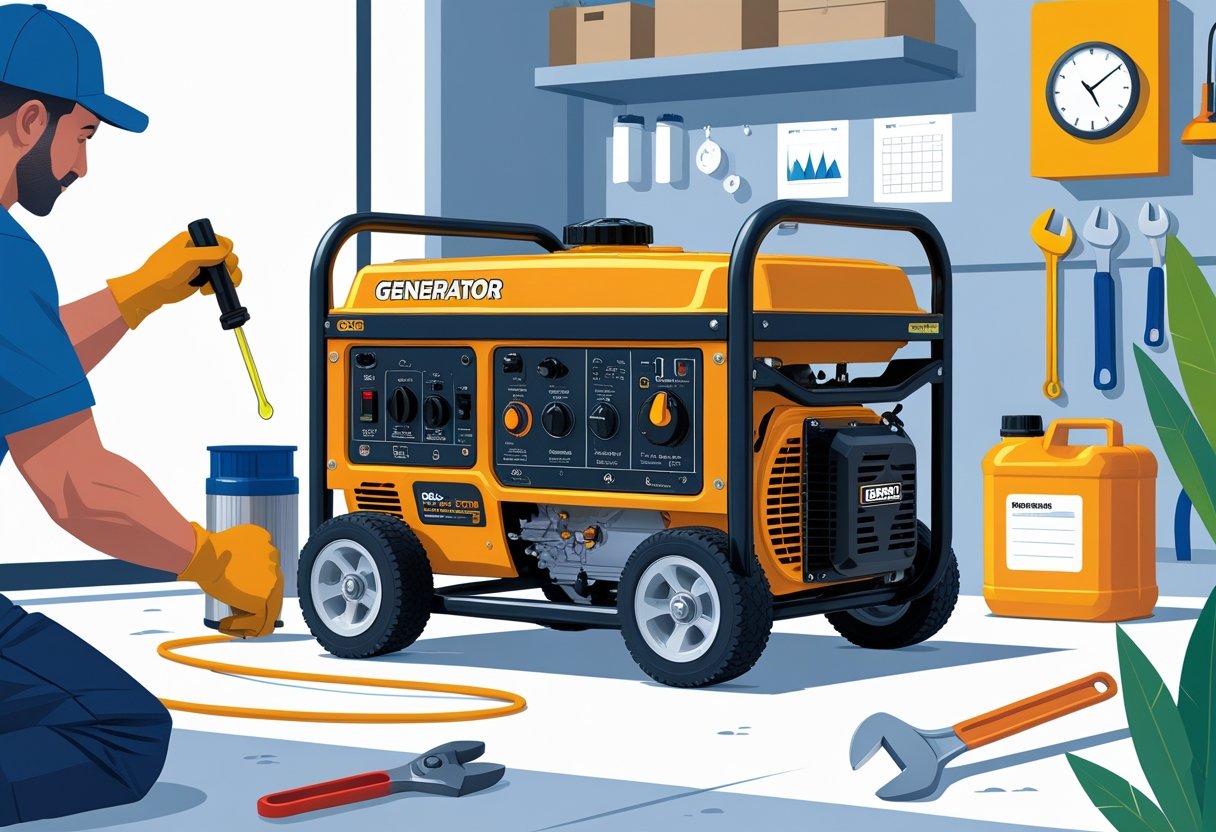Dealing with a tripping circuit breaker can be frustrating, but it’s a common issue you can often handle yourself. Knowing how to troubleshoot your home circuit breaker helps you spot simple problems and keeps your electrical system safe and working smoothly.
You might notice your breaker trips often or your lights flicker in one room. These signs usually point to issues like overloads, loose wiring, or a faulty breaker.
Understanding these common causes lets you act fast and protect your home. Learning a few basic tips gives you confidence to check your breakers and know when to reset, test, or even replace them.
Understanding Home Circuit Breakers
Your home’s circuit breakers protect your electrical system from damage and danger. Knowing how they work, the different types available, and why they trip will help you spot problems early.
How Circuit Breakers Work
Circuit breakers act like switches that control the flow of electricity in your home. When too much current flows through a circuit, the breaker trips and cuts off power to prevent damage or fire.
Inside the breaker, a small wire or strip heats up when current is high. This heat triggers the breaker to switch off.
Some breakers use a magnetic mechanism that reacts quickly to sudden surges or shorts. When a breaker trips, power stops only on that circuit.
You can reset it by flipping the switch back on. This safety feature helps avoid dangerous overloads or short circuits.
Types of Circuit Breakers
There are several common types of breakers you may find at home:
- Standard breakers: Protect against overloads and shorts, resetting manually.
- Ground Fault Circuit Interrupters (GFCI): Detect ground faults, often used in bathrooms or kitchens near water.
- Arc Fault Circuit Interrupters (AFCI): Detect dangerous electrical arcs to reduce fire risks.
- Dual-function breakers: Combine GFCI and AFCI protection for safer electrical systems.
Each type plays a specific role in protecting you and your home from electrical hazards.
Common Reasons Breakers Trip
Breakers trip to protect your home from electrical problems. Some usual causes include:
- Overloaded circuits: Too many devices drawing power at once.
- Short circuits: A direct connection between hot and neutral wires causing excess current.
- Ground faults: Current flowing outside the intended path, often through water or damp areas.
- Faulty appliances: Devices with broken wires or internal problems can cause trips.
If your breaker trips often, check for these issues or get professional help.
Initial Troubleshooting Steps
Starting with basic checks saves time and keeps you safe. You’ll look for visible issues, find which breaker needs attention, and reset it properly to restore power.
Visual Inspection and Safety Precautions
First, look closely at the breaker panel and area around it. Check for signs of damage like scorch marks, burning smells, or loose wires.
If you smell anything unusual or see damaged parts, do not touch the panel. Call a professional electrician because safety comes first.
Before you begin, switch off all devices on the affected circuit. This reduces the risk of overload when you reset the breaker.
Wear rubber-soled shoes and use a flashlight if the area is dark. Make sure your hands are dry to avoid electric shock.
Identifying the Tripped Breaker
Look at your breaker panel for switches that aren’t fully in the “ON” position. Breakers often move to the middle or “OFF” side when tripped.
Some breakers have a red or orange flag to show they have tripped. If your panel doesn’t have these indicators, test each breaker by switching it off and on.
You want to find the breaker causing the problem—usually the one that trips repeatedly or controls the area without power. Label your circuit breakers if they’re not marked to help you quickly identify which part of your home the breaker controls in the future.
Resetting the Breaker Correctly
To reset a tripped breaker, first push it fully to the “OFF” position. Sometimes it needs to be fully turned off before it will switch back on.
After that, flip it back to “ON.” You should feel a firm click that tells you the breaker is reset.
Turn on the devices on that circuit one by one. If the breaker trips again immediately, do not keep resetting it.
If the breaker stays on but trips later, monitor the circuit closely and consider having a professional inspect it.
Pinpointing the Cause of Breaker Trips
A circuit breaker trips when it detects something wrong with the electrical flow. This usually happens because the circuit is overloaded, there’s a short circuit, or a ground fault.
Checking for Overloaded Circuits
An overloaded circuit happens when too many devices or appliances draw power on the same circuit. This makes the breaker trip to stop the wires from overheating.
Look at the devices on the circuit when the breaker trips. Unplug a few or turn some off.
If the breaker stops tripping, the circuit was overloaded. Divide your devices across different circuits if possible.
Avoid running several high-power items like heaters, microwaves, or hairdryers on one circuit.
Detecting Short Circuits
A short circuit occurs when a hot wire touches a neutral or ground wire. This creates a sudden surge in electricity, forcing the breaker to trip.
Signs of a short circuit include a burning smell, sparks, or the breaker tripping right after you turn on a device. To find a short, unplug all devices on that circuit.
Then reset the breaker. Plug in devices one by one and turn them on to find the one causing the issue.
Investigating Ground Faults
A ground fault happens when electricity flows where it shouldn’t, like through the ground wire. It can be dangerous and cause shocks.
GFCI breakers or outlets detect ground faults and trip to protect you. If your breaker trips quickly in wet areas like bathrooms or kitchens, a ground fault may be the problem.
Check for damaged cords or wet outlets. If you suspect a ground fault, use a GFCI tester or call a professional to inspect your wiring.
DIY Fixes for Common Issues
You can solve many circuit breaker problems with simple hands-on steps. These include balancing power use, checking problem appliances, and ensuring all wire connections are secure.
Each task helps keep your electrical system safer and more reliable.
Rearranging Electrical Loads
If your circuit breaker trips often, too many devices may be running at once on the same circuit. Move some appliances to different outlets on other circuits.
Turn off some devices and see if the breaker still trips. If it stops, try plugging heavy power users like heaters or kitchen appliances in other rooms.
Avoid running multiple big devices together. Using a power strip with overload protection can help, but don’t overload the strip itself.
Keeping your electrical load balanced reduces the chance of trips and overheating.
Replacing Faulty Appliances
Sometimes, a single malfunctioning device can cause your breaker to trip repeatedly. Appliances with damaged cords or internal faults often overload the circuit.
Unplug appliances one by one when the breaker trips. If unplugging a certain appliance stops the trips, that device likely needs repair or replacement.
Look for signs like burning smells or unusual noises from the appliance. Don’t ignore these warning signs—they show the device might be unsafe for your home.
Tightening Loose Connections
Loose electrical connections can create heat and cause your breaker to trip. Check your outlet screws and wiring in your breaker box carefully.
Before you start, turn off the main power to avoid shock. Use a screwdriver to tighten screws on outlets and switch plates.
Gently push wires to ensure they are firmly connected under their terminals. If you feel unsure or see damaged wires, call a professional.
For small loose connections, tightening them might stop breaker trips and reduce hazards.
When to Call a Licensed Electrician
Sometimes, circuit breaker issues need special skills. Knowing when to stop and get professional help keeps your home safe and avoids bigger repairs.
Signs of Serious Electrical Problems
If you notice unusual sounds like buzzing or clicking from your breaker panel, this is a warning sign. Flickering or dimming lights, even when you are not using many appliances, can also mean there is a problem with your wiring or breaker.
Burning smells near your breaker or outlets are serious and require immediate attention. These signs can point to faulty wiring or overloaded circuits, which might lead to fire hazards.
If you see any of these problems, call a licensed electrician. They have the right tools and knowledge to fix these issues safely.
Breaker Won’t Reset
When a breaker trips, it usually means it is protecting your home from an overload or a fault. If your breaker won’t stay on after you flip it back, something is wrong beyond a simple reset.
This could mean the breaker is faulty or there is a wiring issue causing the continuous trip. Trying to force it on repeatedly without fixing the root cause can cause damage or electrical shock.
If your breaker won’t reset, call an electrician. They can test the breaker and wiring to find the exact problem and make repairs.
Repeated Tripping After Attempts at Repair
If your circuit breaker trips again and again after you try to reset or fix it yourself, the underlying problem has not been solved. Repeated trips could be caused by an overload, short circuit, or a ground fault.
Ignoring this can put your home at risk for electrical fires or damage to appliances. If you have unplugged devices and still get frequent trips, call a professional.
A licensed electrician can diagnose the cause and make repairs that ensure your electrical system stays safe and reliable.
Preventing Future Circuit Breaker Problems
To keep your circuit breaker working well, check your electrical panel regularly, update old breakers, and use your electrical devices safely.
These steps help avoid frequent trips and potential hazards.
Routine Electrical Panel Inspections
Checking your electrical panel often helps catch problems early. Look for signs like rust, loose wires, or a burning smell.
These can signal issues that might cause breakers to trip or fail. You can inspect the panel yourself by turning off the main power and looking inside.
For a more thorough check, hire a licensed electrician. They can test the breakers and wiring to make sure everything is safe and working right.
Routine inspections can save you from bigger problems, like electrical fires or damage to your appliances. Set a schedule to inspect your panel every year or two.
Upgrading Outdated Breakers
If your home is old or has old breakers, upgrading is a smart move. Breakers can wear out or become less safe over time because of age or damage.
Old breakers may trip often or not trip when they should, which is dangerous. New breakers use better materials and technology, so they protect your home more effectively.
Call an electrician to replace outdated breakers. They can recommend the right breaker size and type for your home's needs.
Upgrades protect your home and can improve electrical performance.
Practicing Safe Power Usage
How you use electricity affects your breaker’s performance. Plugging too many devices into one circuit can overload and trip the breaker.
Avoid using high-power appliances on the same circuit at the same time. Spread devices across different outlets or circuits to balance the load.
Unplug appliances when not in use. Replace any damaged cords.
Using electric devices safely lowers the chance of trips and damage.
Tips for safe power use:
- Don’t overload outlets
- Use power strips with surge protection
- Avoid DIY electrical work without knowledge
Frequently Asked Questions
You might notice issues like flickering lights, frequent tripping, or no power at all when a breaker has problems. Spotting and fixing these signs helps you keep your home safe and avoid bigger electrical issues.
What are the signs that a circuit breaker might be faulty?
If your breaker trips often, it could be worn out or handling too much load. Flickering lights, burning smells, or a breaker that won’t reset are also signs it might be bad.
How can you determine if a breaker is bad when there's no power?
Use a voltmeter to check if power reaches the breaker. If there’s no voltage, or the breaker won’t reset but trips immediately, it likely has a fault.
What steps should you take to fix a malfunctioning circuit breaker?
Turn off all devices on the affected circuit. Reset the breaker by switching it fully off and on.
If it trips again, call a professional to inspect wiring or replace the breaker.
Can a circuit breaker fail without tripping, and what should you look for?
A breaker can fail silently. Watch for flickering lights, warm breaker panels, or burning smells.
These signs mean the breaker or wiring might be unsafe even if it hasn’t tripped.
What is the proper way to replace a defective circuit breaker?
Turn off the main power to the panel for safety. Remove the old breaker carefully, then install the new one.
Make sure all connections are tight. Double-check everything before turning the power back on.
What are the symptoms of a bad main breaker in a home electrical system?
A bad main breaker can cause the whole house to lose power. You might also have frequent unexplained outages.
The panel may feel hot. You could see visible damage inside the breaker box.





